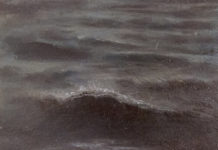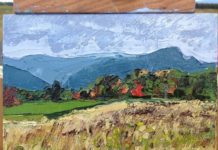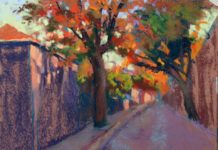
To fulfill a long-standing ambition to paint an expansive view of the Iguassu Falls of South America, Donald Neff made acrylic studies on location and took them back to California to develop a 36” x 72” studio oil painting. A step-by-step demonstration of how Neff created that painting will be included in the digital edition of the January 2013 issue of PleinAir. Here’s a brief preview.

The view from the top of the falls that Neff painted first
Ever since Donald Neff first saw photographs of Iguassu Falls in South America, he was determined to visit the aquatic display, located between Argentina and Brazil. He wanted to paint the falls and then do a large studio painting that suggested its monumental nature. The artist finally fulfilled that ambition in January 2012, when he and a group of about 20 friends took a tour of South America.
Neff paints both in oils and in acrylics. “Although I generally favor oils,” he says, “I take acrylic paints along on international trips because the water-soluble colors are much easier to get through airport security and customs, and they don’t make it necessary to secure solvents and mediums. Moreover, the paints dry in a few minutes and make it easy to layer colors and then quickly pack up and leave a location.”

Neff’s painting materials spread out
The artist’s small paint kit consists of about eight or 10 tubes of acrylic colors, several pads of canvas sheets in various sizes (8.5” x 11”, 9” x 12”), several paintbrushes (brights and a few rounds of various sizes), disposable paper palettes, a plastic palette knife, a small spray bottle, rolls of paper towels, a pencil or two, and four or more large paper clamps (very important to keep canvas and palette sheets clamped in the wind). Neff improvises when it comes to obtaining water and a disposable cup.
Except for the palette and canvas pads, all these supplies fit into a 9” x 6” x 3” travel pouch. When traveling this light, Neff generally doesn’t bring an easel, “stay-wet” palettes, or boxes of other equipment because those would only add bulk and weight. He sometimes holds a canvas in his hand or lays it flat if a support is available.

“Iguassu Falls,” by Donald Neff, 2012, acrylic, 9 x 12 in. Collection the artist. This is the artist’s first study of the falls.
Neff’s first plein air study of the spectacular landscape was done at the top of the falls. “When painting water in general, and waterfalls in particular, it’s necessary to apply many layers of acrylic color in order to suggest both the depth and reflective surfaces,” he explains. “I usually work from the darker values to the lighter ones, and I sometimes glaze darker wash over lighter values. Since acrylic paints dry quickly, it is a little more difficult to get a soft, moving look of falling water than it would be with slower-drying oils, but glazing along edges can yield a convincing illusion of motion.”
The palette of acrylic colors Neff uses includes ultramarine blue, cobalt blue, quinacridone red, cadmium red medium, sap green, transparent iron oxide, cadmium orange, yellow ochre (sometimes raw sienna), cadmium yellow medium, and titanium white. He sometimes adds other colors, including thalo blue and thalo green.
Neff premixes a combination of ultramarine blue and quinacridone red to form a dark purple, and he combines cobalt blue and cadmium red to get a rich gray. These purples and grays can be modified with other colors. For example, yellow ochre can be added to the gray to get a grayish green that is useful for painting distant trees and foliage.
Once Neff was back in the studio, and before embarking on the development of a large 36” x 72” painting, he created a small 12” x 24” study based on the plein air sketches and photos taken on location. Translating the acrylic studies and photos was a vital step to ensuring the composition, values, color, and other elements of the painting all worked prior to scaling up to such a large canvas.
Having resolved all the major issues while creating studies, Neff could avoid using any type of grid system to enlarge the image onto the larger canvas. Instead, he relied on rough measurements and approximations. He says, “I just drew in the basic sketch on the large canvas and made minor adjustments along the way to fit the size.”

“Cataratas do Iguaçu,” by Donald Neff, 2012, oil, diptych, 36 x 72 in. Collection the artist
As Neff reached the end of the painting, he realized the sky was too light and needed to be darkened to make the distant falls stand out. He also made adjustments throughout the painting, toning down and adding more mist to the distant falls. After much consideration, Neff decided not to paint in the bridge and walkway you see in the original photo. For more information, visit www.donaldneff.com




